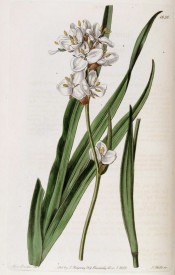Libertia formosa Graham
Hardy rhizomatous perennial with sword-shaped leaves, to 30cm long, and white flowers borne in dense clusters. [RHSD, Hortus].
Horticultural & Botanical History
‘We are obliged to Mr. Lowe, of the Clapton Nursery, for the opportunity of figuring this rare plant, which was found by Mr. James Anderson in the island of Chiloe growing on the sea-shore within reach of the waves, it is a half-hardy herbaceous plant, flowering in May, and increased by dividing the root-stock. Dr. Graham […] judiciously adopts the name Libertia for this genus, in preference to that of Nematostigma given it by Dietrich. The Libertia of Lejeune, or Michelaria of Dumortier, is considered with good reason to be a Bromus.’ [BR f.1630/1833].
‘This Genus was separated from Sisyrinchium by Mr. Brown, and the name of Renealmia, for a time suppressed by Smith, given to it; but as the Genus Renealmia has been restored upon good grounds by Roscoe, it becomes necessary to adopt from Sprengel the applellation of Libertia for the Genus of Brown, which is a natural one.’ [BM t.3294/1834].
History at Camden Park
Libertia formosa is marked with a ‘c’ in an 1836 edition of Loddiges’ catalogue held at Camden Park [CPA]. In William Macarthur’s code, used and explained elsewhere, this means grown at Camden. It is almost certain that it was grown in the gardens around this time but may have been short lived as it did not appear in the catalogues.
Notes
Published Nov 19, 2009 - 02:45 PM | Last updated Jul 24, 2010 - 05:02 PM
| Family | Iridaceae |
|---|---|
| Category | |
| Region of origin | Chile |
| Synonyms |
|
| Common Name | |
| Name in the Camden Park Record | Libertia Formosa |
| Confidence level | high |
